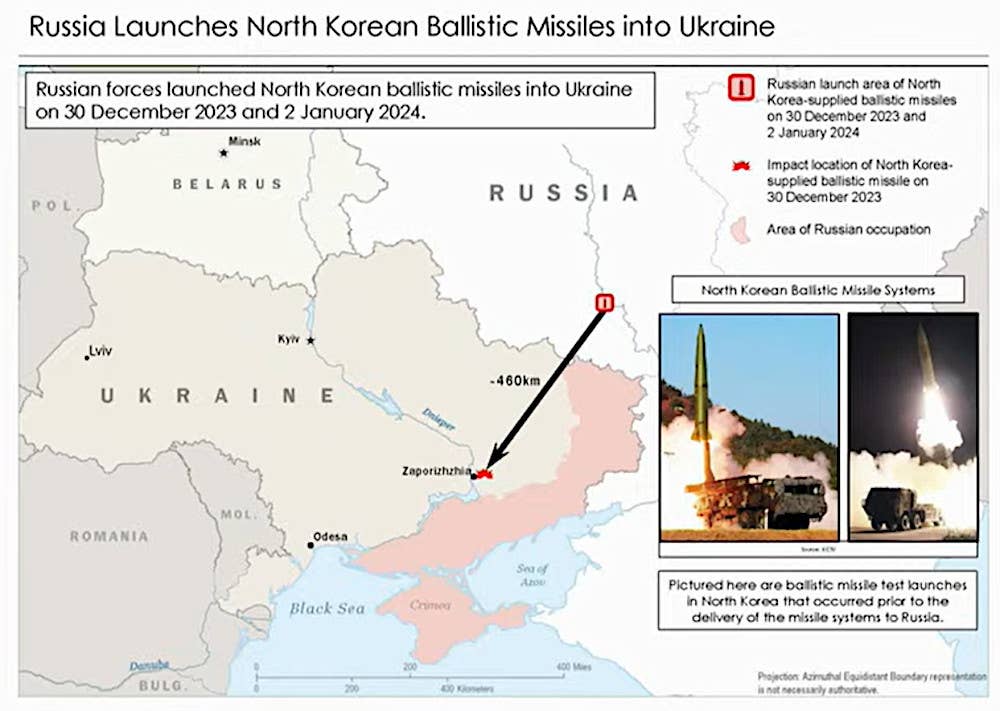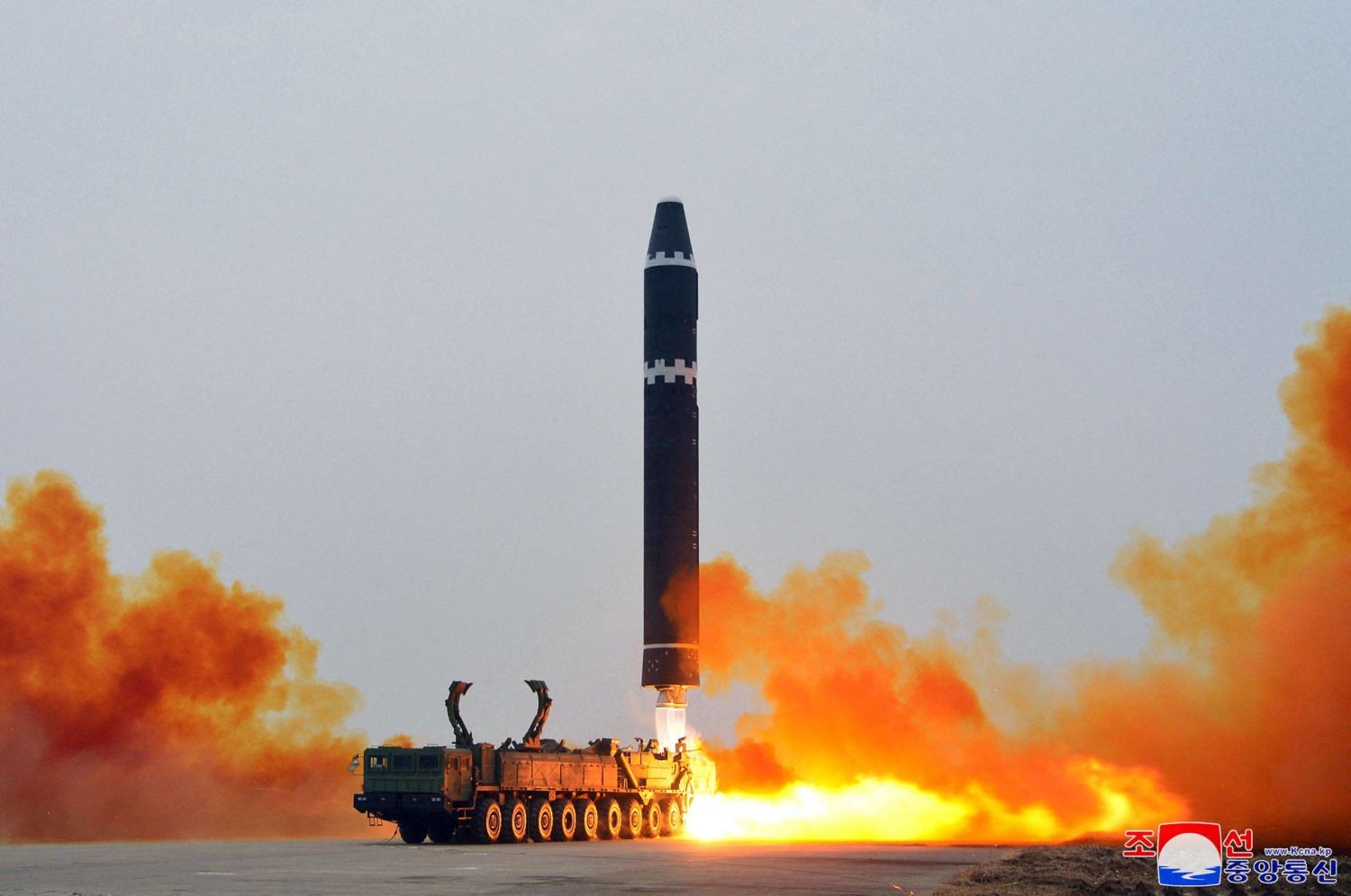Confirming the claims made by the United States on January 4, Mykhailo Podolyak, a close aide to the Ukrainian President, said Russia indeed fired North Korean missiles on Ukraine for the first time in this ongoing war.
“There is no longer any disguise…as part of its outright genocidal war, the Russian Federation for the first time struck at the territory of Ukraine with missiles received from…North Korea,” Podolyak wrote on Platform X on January 5.
Earlier, the top spokesperson for the White House’s National Security Council (NSC) announced that Russian forces are now firing North Korean-made short-range ballistic missiles at targets inside Ukraine. The assertion was made in a press conference and was said to be based on a credible intelligence report obtained by Washington.
In a strongly worded statement, John Kirby said, “Information indicates that the Democratic People’s Republic of Korea [the official name of North Korea] recently provided Russia with ballistic missile launchers and several ballistic missiles.”
The announcement caused a stir globally, even though it was a long time coming, with sporadic reports about arms deals between the two Cold War allies that have stuck together through the Russian military offensive on Ukraine.
“On the 30th of December 2023, Russian forces launched at least one of these North Korean ballistic missiles into Ukraine. This missile appears to have landed in an open field in the Zaporizhzhia region [in southeastern Ukraine],” according to Kirby.
There is no longer any disguise… As part of its outright genocidal war, the Russian Federation for the first time struck at the territory of #Ukraine with missiles received from… North Korea. The masks are completely off. The #Moscow regime is no longer concealing its…
— Михайло Подоляк (@Podolyak_M) January 5, 2024
He further added, “On January 2, Russia launched multiple North Korean ballistic missiles into Ukraine, including as part of this overnight aerial attack. We’re still assessing the impacts of these additional missiles.”
The revelation comes at a time when Russia has launched one of its massive missile and drone attacks on Ukraine, starting from the last two days of 2023. One of the worst attacks was carried out on January 2, which included hundreds of missiles and drones being fired on Kyiv and adjoining areas.
This also included hypersonic missiles. Most of them were aimed at Ukrainian military and defense industry complexes.
The White House would not specify the kind of missiles Pyongyang had shipped to Russia. Still, Kirby revealed a graphic purportedly depicting KN-23 and KN-25 short-range ballistic missiles (SRBMs) and stated that they had a range of roughly 900 kilometers.
Images from Ukrainian social media accounts, according to Joost Oliemans, a Dutch researcher and expert on North Korea’s military, clearly show portions of the ring holding the control vanes that are typical of North Korea’s Hwasong-11 family of missiles, which includes the KN-23 and KN-24. There has been no official confirmation on the missile launched.
https://twitter.com/clashreport/status/1743195031932915919
In his announcement, Kirby also noted that this had been a transaction in kind, with North Korea anticipating receiving fighters, armored vehicles, surface-to-air missiles, and other equipment and technology transfers, including support for the country’s internal ballistic missile production.
There have been several reports emanating from Washington that arms supplies may be taking place between Pyongyang and Moscow. The White House warned in September last year that North Korea “would pay a price if it supplied Russia with weapons for the conflict in Ukraine.”
Experts have long maintained that Moscow would ask for artillery shells and anti-tank missiles. Siemon Wezeman, a senior researcher at the Stockholm International Peace Research Institute, said, “North Korea might have had large stocks of ammunition that Russia could use.”
Authorities in South Korea claimed in November that North Korea might have given Russia SRBMs as part of a broader arms sale that also included rifles, artillery and mortar ammunition, anti-aircraft and anti-tank missiles.
At the time, the South Korean military claimed that about 2,000 containers of military equipment and munitions were shipped from North Korea’s northeastern port of Rajin to Vladivostok in Russia’s Far East.
The assessment was reportedly derived from satellite imagery analyzed by it. However, both sides have continued to refute the claims. For one, the Russian Ministry of Defense has yet to respond to the allegations.
Throughout the ongoing war, several reports indicated that Russia was running out of its stock of SRBMs faster than it could produce them. This gave rise to speculations that it would try sourcing these missiles from its allies, North Korea and Iran.
After North Korean ballistic missiles were used against Ukraine, there are reports that Moscow is courting the Iranian administration to supply ballistic missiles to aid the offensive against Kyiv.
Russia Could Acquire Ballistic Missiles From Iran
Kirby also addressed ongoing worries that Russia is pressuring Iran to supply more short-range ballistic missiles. These concerns have lingered for a while, significantly intensifying since the fall of last year.
Citing unnamed Iranian officials, Reuters said in October 2022 that Russia and Iran had signed an agreement for drones and short-range ballistic missiles.
Later, a report by the Washington Post stated that an intelligence assessment shared with US and Ukrainian officials warned that Iran is preparing to ship short-range Fateh-110 and Zolfaghar tactical ballistic missiles to Russia. The two missiles can strike targets at 300 and 700 kilometers, respectively.

These speculations started taking shape further when the IRGC stationed ballistic missiles and missile support systems at a training facility inside Iran in mid-December to show off to a visiting Russian delegation. This confirmed that Russia plans to buy the systems from Iran after a successful combat run of the Shahed-class kamikaze drones.
Iran has developed a vast arsenal of ballistic missiles of various ranges, making it a formidable regional power in the Middle East. As per the Western estimates, there are at least 20 different Iranian ballistic missile designs, different sub-variants not included, offering a wide variety of missiles for Russia to choose from for various purposes.
However, Ukrainian officials admitted earlier that despite the speculations, Tehran was dilly-dallying on the transfer of missiles due to tremendous diplomatic pressure from the West. Iran has come under substantial diplomatic pressure, and the protests have also raised pressure on the government,” the Presidential advisor stated from his Kyiv office last year.
There is probably more to Russia’s alleged acquisition of ballistic missiles from Iran than just the worrying depletion of its cruise and ballistic missile stock. Experts suggested earlier that Russia would be willing to sacrifice cheap Iranian missiles for its own sophisticated and expensive ones, which may be due to the capability of Ukraine’s Western-origin missile defense systems to intercept ballistic missiles.
- Contact the author at sakshi.tiwari9555 (at) gmail.com
- Follow EurAsian Times on Google News




